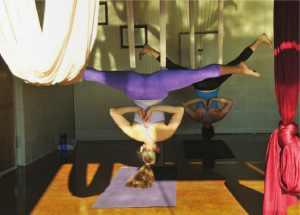Yoga Uplifted
Aerial Yoga Takes off in Massachusetts
Published in baystateparent magazine

courtesy of Ebb n' Flow Yoga
I enter the room at Ebb n’ Flow Yoga, where the colorful silk hammocks hang from the ceiling, inviting me to sink into one and try out a new yoga practice that is taking flight around Massachusetts and the world.
I can’t wait. Honestly? I am not a yogi seeking the next stage of enlightenment. I’m just a regular mom with a lot of responsibilities, a woman who provides support to others in her everyday world, looking for a way of support that frees me to explore and stretch my body and mind, and have some playful fun, too.
This is what aerial yoga does.
Ebb n’ Flow Yoga in Northborough, MA offers both traditional and aerial yoga. Owner and instructor Kim Gebo is seeing an increasing interest in the aerial classes, primarily for the unique experience and benefits that aerial yoga provides.
“In aerial yoga, you have gravity assisting you, and the hammock supporting you, as you work through the poses,” she says. “The silk holds you, it supports you. There’s a feeling of weightlessness, of confidence, of trust. It is very empowering to be able to do something that you couldn’t do on the mat.”
Aerial yoga as a genre was founded by former dancer and gymnast Christopher Harrison, who also founded Suspension Fitness. Today, aerial yoga is practiced in varying forms that incorporate Harrison’s original vision and intention of suspended yoga and fitness. Whether it’s Harrison’s AntiGravity® Aerial Yoga, the upbeat Fly Gym® Aerial Fitness, or other variations of yoga – all aerial yoga classes incorporate a hammock or sling suspended from the ceiling as a support. Traditional mat poses are done using the hanging fabric as a support for arms, feet or hips. Suspended poses are done while seated or standing in the hammock, and inversions allow spinal extension. Aerial yoga literally extends yoga from the mat on the floor to a safe, supported, suspended environment.
Beth Peterson, owner of Escape Aerial Arts in Worcester, offers Fly Gym Aerial Fitness® classes, where participants use a stretchy cotton sling for suspended athletic conditioning, aerial yoga & Pilates exercises. The Fly Gym class I attended felt more like an interactive fitness than yoga class. Beth leads students through poses, stretches, and inversions, with popular music playing in the background.
“We don’t do traditional yoga in terms of relaxation and meditation. Our students generally aren’t looking for the ‘om’ aspect,” she says. “We talk during class. Everybody wants to know the person next to them. It’s a happy place. It’s a place to go to be among supportive people,” she says.
“Whether it’s using the silk hammock or the jersey fabric, either way, you can get deeper into yoga poses with the gravity assisting you,” she says. “You’re supported, you can relax into them. You’re not holding your body weight, the hammock or the sling is there to support you,” she says.
Lauren Kennedy of Northborough, MA decided to try aerial yoga as an alternative to swimming and walking. Kennedy had spinal surgery years ago to correct her scoliosis, and was searching for a way to help alleviate back pain and gently stretch her body. She first tried yoga to help with spinal decompression and extension. Then she tried aerial yoga at Ebb n’ Flow Yoga and fell in love.
“The movement itself is very gentle, and I love that,” she says. “You almost feel as if you’re floating on your back in the sky. You feel like you’re cradling, and you let everything else go. That’s what’s really wonderful about it,” she says.
Kennedy’s favorite poses are the inversions. “I love being upside down. It’s the closest thing I can think of to swimming. Hanging upside down is great for me, for my specific needs, but you don’t have to be injured to enjoy it,” she says.
Kennedy says while it can be challenging for women to try something new physically, especially as they age, she found aerial yoga to be surprisingly easy to do.
That sentiment is echoed by most students new to the practice. “Aerial yoga is something that you can pick up really quickly,” Peterson says. “People are always surprised by that. They think, ‘I’m not going to be able to do this, I have no strength, no flexibility.’ They try it, and end up doing things that they never imagine that their body was capable of, and it leads to empowerment and excitement. They feel so good about themselves.”
Maureen Ferdinand, a new mom from Ashland, says aerial yoga is “fun, different and unique.” Ferdinand was very active before the birth of her child, participating in triathlons and other endurance events. She’s been practicing aerial yoga for three years, and continues to take a class once a week. Ferdinand finds that aerial yoga makes her feel more peaceful and grounded.
“I actually don’t know how to do ‘regular people’ yoga,” Ferdinand quips. “You go to a regular class, and you don’t know the pose. Not only is the aerial yoga super fun because you are swinging around, but the instructor describes the poses and uses poses. It’s cool. You get to be like a kid, it’s playful,” she says. “I feel happier when I walk away from the class.”
Both studio owners I visited stressed the importance of equipment safety and instructor experience in aerial yoga. Since the hammocks are suspended from the ceiling, the rigging needs to be secure. They suggest that new students inquire about rigging, safety checks, and the training and experience the instructor has in aerial yoga. In addition, students should always feel comfortable with the fabric and the poses they do. And if they have any medical conditions that prevent them from inverting, they should let the instructor know. When trying aerial yoga, I was able to do the upright poses, but not inversions because of vertigo.
“No one is asked to do something that their body is not comfortable doing,” says Gebo.
Other recommendations for first-time students are to come to class on an empty stomach, wear form-fitting pants and shirt with sleeves, and avoid wearing jewelry or any other loose-hanging items.
Like traditional yoga done on a mat, aerial yoga can be as gentle or as challenging as the person practicing it wants to take it. And, it’s much more than just a physical workout.
“It’s not about just physical stretching, it’s about stretching your own mind,” Gebo says. “If your mind is what’s holding you back, in the aerial classes you are confronted with that rather quickly. On the other hand, when you find that pose in aerial that you’re not able to do on the mat, you feel so empowered. You go from one extreme from the next. There’s this fear at first, then you’re confronted, then there’s trust, then there’s, ‘Wow! I just did that!’ It’s really neat. I love seeing people get it,” she says.
Aerial yoga doesn’t have to just be for adults. Many studios offer pre- and post-natal classes for moms, and “Mommy and Me” aerial classes for younger children. Older children can benefit, too.
Gebo has held classes for preteen girls, and believes that both traditional and aerial yoga can go a long way in building confidence in kids.
“Yoga can help children find their true value,” she says. With yoga, you’re not comparing yourself with someone else. With children that’s so important. Especially for young girls these days,” she says.
There are also smiles and laughs in aerial yoga as students try different poses – a reaction not usually seen in traditional yoga classes. “Sometimes we laugh at ourselves and embrace the moment,” says Kennedy.
Kennedy believes that aerial yoga is “a gift you give yourself. If you give that gift to yourself, than you can give back to others, too,” she says.
 My professional experience includes leading the creative efforts of three companies I have co-owned. I'm a seasoned copywriter/creative director, award-winning journalist, avid runner, and mom of four. Got a story idea you'd like to share? Email me at treske@nowspeed.com. You can also find me on Twitter: @trishreske, LinkedIn and Facebook.
My professional experience includes leading the creative efforts of three companies I have co-owned. I'm a seasoned copywriter/creative director, award-winning journalist, avid runner, and mom of four. Got a story idea you'd like to share? Email me at treske@nowspeed.com. You can also find me on Twitter: @trishreske, LinkedIn and Facebook.